LightSail 2 Spacecraft Successfully Demonstrates Flight by Light
Years of computer simulations. Countless ground tests. They've all led up to now. The Planetary Society's crowdfunded LightSail 2 spacecraft is successfully raising its orbit solely on the power of sunlight.
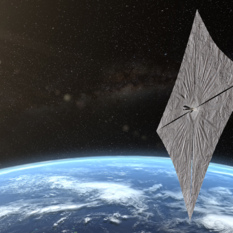
LightSail is a citizen-funded project from The Planetary Society to send a small spacecraft, propelled solely by sunlight, to Earth orbit.
Since unfurling the spacecraft's silver solar sail last week, mission managers have been optimizing the way the spacecraft orients itself during solar sailing. After a few tweaks, LightSail 2 began raising its orbit around the Earth. In the past 4 days, the spacecraft has raised its orbital high point, or apogee, by about 2 kilometers. The perigee, or low point of its orbit, has dropped by a similar amount, which is consistent with pre-flight expectations for the effects of atmospheric drag on the spacecraft. The mission team has confirmed the apogee increase can only be attributed to solar sailing, meaning LightSail 2 has successfully completed its primary goal of demonstrating flight by light for CubeSats.
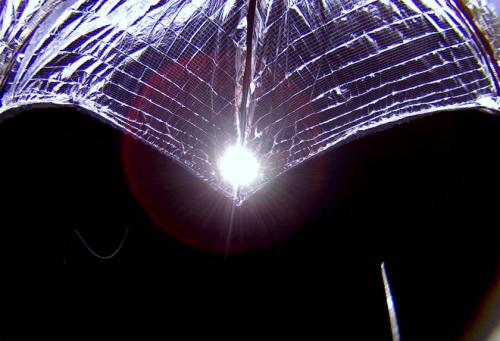
LIGHTSAIL 2 DURING SAIL DEPLOYMENT SEQUENCE (CAMERA 1)
This image was taken during the LightSail 2 sail deployment sequence on 23 July 2019 at 11:49 PDT (18:49 UTC). The sail is almost fully deployed here and appears warped near the edges due to the spacecraft's 185-degree fisheye camera lens. The image has been color corrected and some of the distortion has been removed. The Sun is visible at center, and pieces of spectraline, which were used to hold LightSail 2's solar panels closed, can be seen at 5 o'clock and 7 o'clock.
"We're thrilled to announce mission success for LightSail 2," said LightSail program manager and Planetary Society chief scientist Bruce Betts. "Our criteria was to demonstrate controlled solar sailing in a CubeSat by changing the spacecraft’s orbit using only the light pressure of the Sun, something that’s never been done before. I'm enormously proud of this team. It's been a long road and we did it."
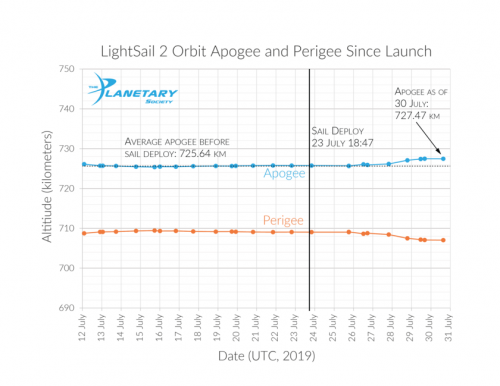
LIGHTSAIL 2 ORBIT APOGEE AND PERIGEE SINCE LAUNCH
This chart shows LightSail 2’s orbit apogee and perigee since launch. From 26 July to 30 July, the spacecraft raised its orbital high point, or apogee, by about 2 kilometers. A PDF version of this chart is available.
The milestone makes LightSail 2 the first spacecraft to use solar sailing for propulsion in Earth orbit, the first small spacecraft to demonstrate solar sailing, and just the second-ever solar sail spacecraft to successfully fly, following Japan's IKAROS, which launched in 2010. LightSail 2 is also the first crowdfunded spacecraft to successfully demonstrate a new form of propulsion.
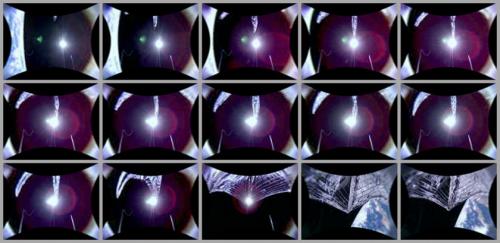
LIGHTSAIL 2 SAIL DEPLOYMENT THUMBNAILS (CAMERA 1)
These images show the progression of LightSail 2’s solar sail deployment sequence, which began on 23 July 2019 at 18:47 UTC. They are all thumbnail images from Camera 1 with an original resolution of 120 by 90 pixels and have been de-distorted and color-corrected. The first 13 frames were taken at intervals of 10 seconds; the remaining ones at intervals of 30 seconds.
"For The Planetary Society, this moment has been decades in the making," said Planetary Society CEO Bill Nye. "Carl Sagan talked about solar sailing when I was in his class in 1977. But the idea goes back at least to 1607, when Johannes Kepler noticed that comet tails must be created by energy from the Sun. The LightSail 2 mission is a game-changer for spaceflight and advancing space exploration."
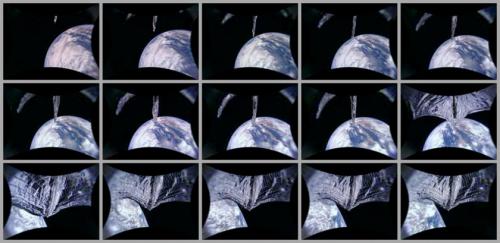
LIGHTSAIL 2 SAIL DEPLOYMENT THUMBNAILS (CAMERA 2)
These images show the progression of LightSail 2’s solar sail deployment sequence, which began on 23 July 2019 at 18:47 UTC. They are all thumbnail images from Camera 2 with an original resolution of 120 by 90 pixels and have been de-distorted and color-corrected. The first 13 frames were taken at intervals of 10 seconds; the remaining ones at intervals of 30 seconds.
On Monday, LightSail 2 sent home a new full-resolution image captured by its camera during solar sail deployment. The perspective is opposite to last week’s full-resolution image and shows the sail more fully deployed. LightSail 2's aluminized Mylar sail shines against the blackness of space, with the Sun peeking through near a sail boom.
The mission team will continue raising LightSail 2's orbit for roughly a month, until the perigee decreases to the point where atmospheric drag overcomes the thrust from solar sailing. During the orbit-raising period, the team will continue optimizing the performance of the solar sail.
"We've been working since sail deployment to refine the way the spacecraft tracks the Sun," said LightSail 2 project manager Dave Spencer. "The team has done a great job getting us to the point where we can declare mission success. Moving ahead, we're going to continue working to tune the sail control performance and see how much we can raise apogee over time."
One such refinement involves LightSail 2's single momentum wheel, which rotates the spacecraft broadside and then edge-on to the Sun each orbit to turn the thrust from solar sailing on and off. Momentum wheels can “saturate,” hitting predefined speed limits, after which they are no longer effective at rotating the spacecraft. Most spacecraft use chemical thrusters to desaturate momentum wheels; LightSail 2 relies on electromagnetic torque rods, which orient the spacecraft by pushing against Earth's magnetic field.
LightSail 2’s momentum wheel currently reaches its saturation limit a couple of times per day, and desaturating the wheel temporarily takes the spacecraft out of its proper orientation for solar sailing. The mission team already applied a software update that increased the time between saturation events, and is also working to automate the desaturation process. Both refinements should result in improved solar sailing performance.
After LightSail 2's month-long orbit raising phase, the spacecraft will begin to deorbit, eventually reentering the atmosphere in roughly a year. The aluminized Mylar sail, about the size of a boxing ring, may currently be visible for some observers at dusk and dawn. The Planetary Society's mission control dashboard shows upcoming passes based on user location, and includes a link to a page that highlights passes when the sail is more likely to be visible.
Roughly 50,000 Planetary Society members and private citizens from more than 100 countries, as well as foundations and corporate partners, donated to the LightSail 2 mission, which cost $7 million from 2009 through March 2019.
"LightSail 2 proves the power of public support," said Planetary Society COO Jennifer Vaughn. "This moment could mark a paradigm shift that opens up space exploration to more players. It amazes me that 50,000 people came together to fly a solar sail. Imagine if that number became 500,000 or 5 million. It’s a thrilling concept."
Source: The Planetary Society
- 224 reads
Human Rights
Ringing FOWPAL’s Peace Bell for the World:Nobel Peace Prize Laureates’ Visions and Actions

Protecting the World’s Cultural Diversity for a Sustainable Future

The Peace Bell Resonates at the 27th Eurasian Economic Summit

Declaration of World Day of the Power of Hope Endorsed by People in 158 Nations

Puppet Show I International Friendship Day 2020

